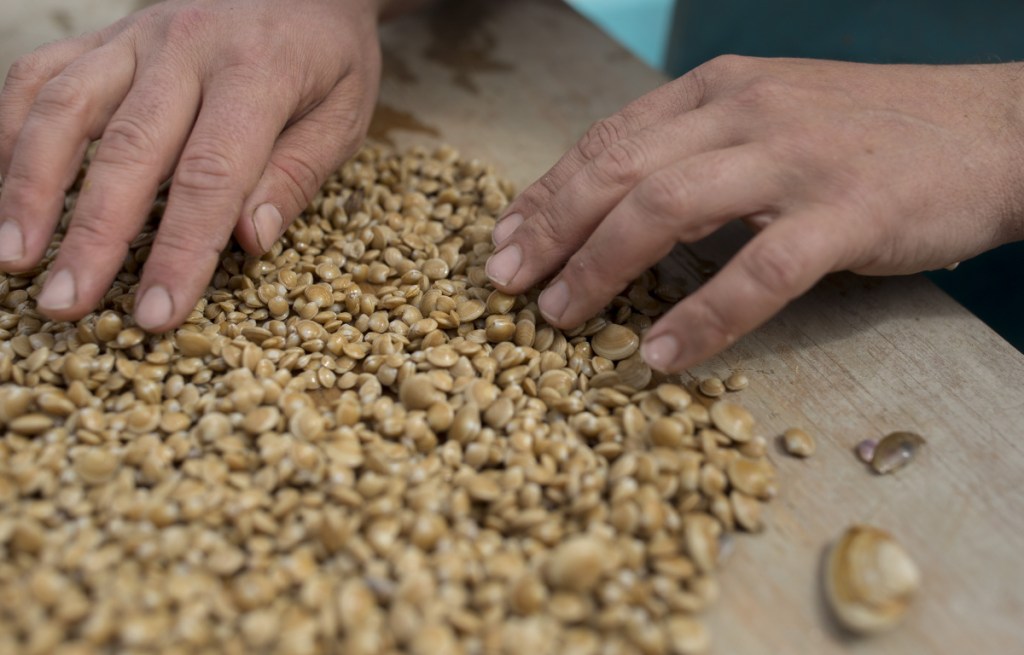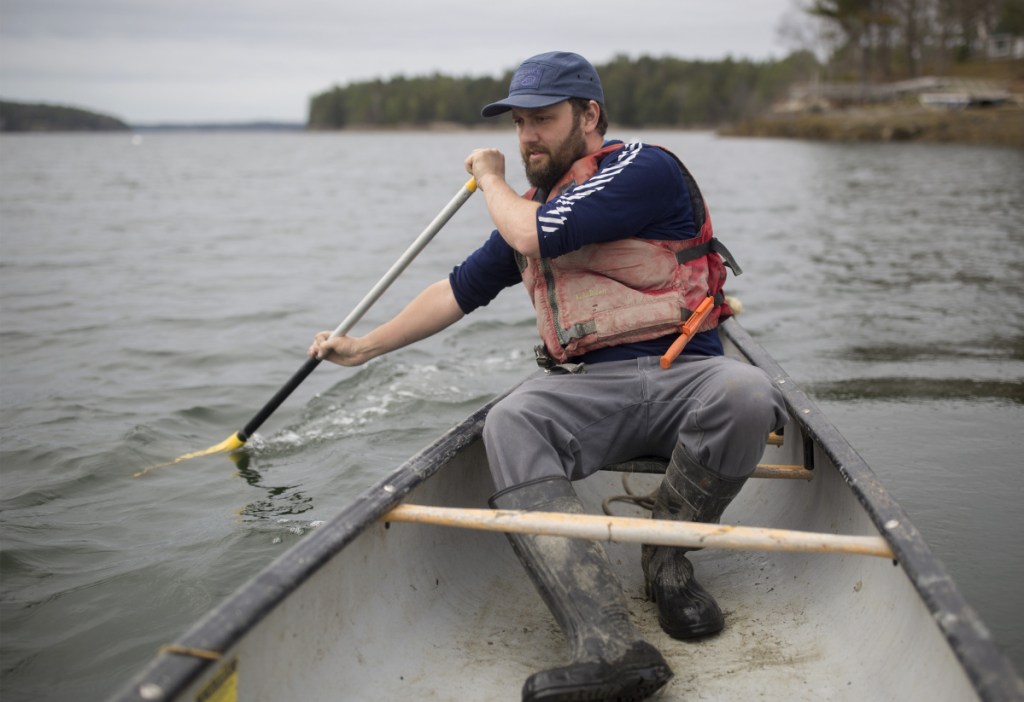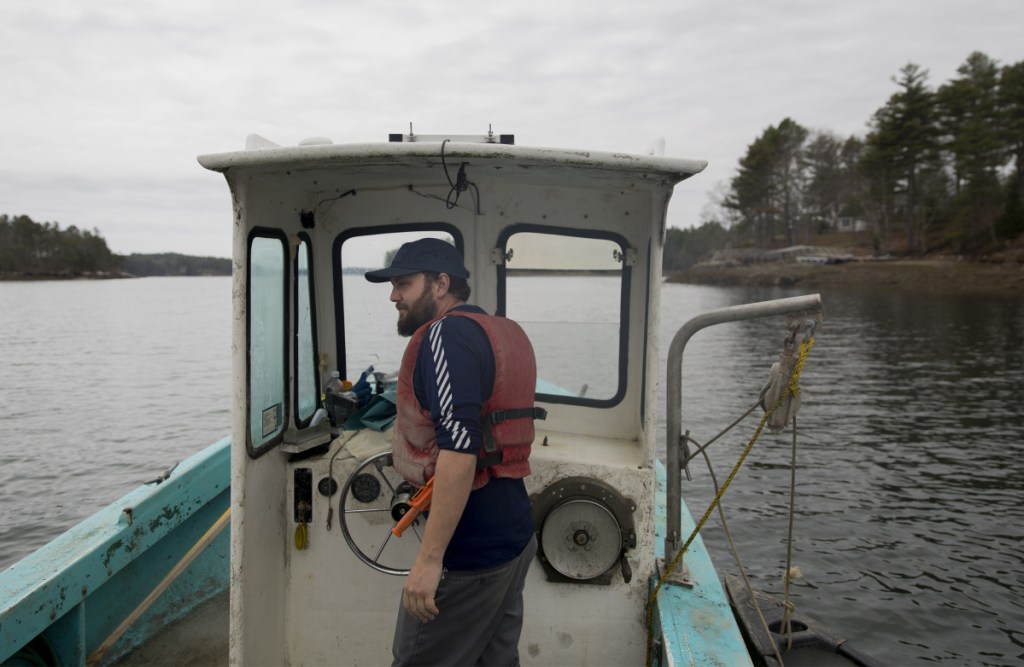WEST BATH — Jordan Kramer stood on the deck of his boat, the Muffin II, looking down at a pile of hundreds and hundreds of cream- and buff-colored quahogs spread out on a piece of plywood in an area roughly the size of a dinner platter.
“A lot of work has gone into this small pile of clams,” Kramer said.
Even though the clams are too tiny to even think about eating, that small pile was a success story. He’d planted 80,000 Mercenaria mercenaria (the proper name for what are more commonly called quahogs or hard-shell clams) seeds in June 2017, and lost half early on. Handling seed of 1 mm or smaller without losing some is not easy. But of those that remained, between 90 and 98 percent of his baby quahogs had survived their first winter on the New Meadows fish farm. Since June, the seed clams had shot up to 11 mm, and even 17 mm in size. They would have stopped growing around November, when Kramer put the farm to bed, but in the warming days of spring, they’re already getting bigger.
Kramer went into aquaculture for the oysters, starting Winnegance Oyster Farm in 2014, and now has regular customers that range from wholesalers Harbor Fish and Upstream Trucking to restaurants like Woodford Food + Beverage and Island Creek’s The Shop, both in Portland. Last year, he began to diversify with Mercenaria mercenaria, using seed he purchased from Muscongus Bay Aquaculture, which has a hatchery in Bremen. He’s hoping to bring the quahogs to market in September, if all goes well this growing season. At that stage, they’d be called littlenecks (bigger quahogs are usually called cherrystones).
Farming littlenecks, Kramer is at the very edge of what could be the next trend in Maine aquaculture. Quahogs have a northern range that typically extended to Massachusetts. For years they have had a relatively small presence in Maine waters, in pockets, particularly around the Brunswick area, but in the era of climate change and rising ocean temperatures in the Gulf of Maine, quahogs in the wild seem to be increasing.
“We are seeing sort of an expansion of their range northward,” said Jon Lewis, who oversees aquaculture leases for Maine’s Department of Marine Resources.
Kramer is trained as a wildlife biologist, and part of his reasoning for growing Mercenaria mercenaria is taking advantage of those warming waters for crop diversification. He already operates two 400-square-foot aquaculture leases and is permitted for two more this year. It’s going well with oysters, but a second crop is a good way to hedge one’s bets.
“This is my insurance policy,” Kramer said of the quahogs.
He had considered kelp, but the littlenecks made more financial sense. They have the potential to fetch a good price, particularly in the size range of about 11/2 inches, ideal for raw bars. “Littlenecks are unique in that they are more valuable at a smaller size,” Kramer said.
Adult-sized Mercenaria mercenaria are far less subject to the predation from green crabs and milk ribbon worms that is ravaging populations of soft-shell or steamer clams. But as seed, or even the size of the baby clams on the deck of the Muffin II on a May day, they are vulnerable. Kramer figured he could give the species a boost by growing it within the netted protection of his oyster farm.
“It’s a smart thing to do,” Lewis said. “We have seen some soft-shell clams disappear and hard-shell seem to be doing better in Casco Bay.”

Kramer hauls in one of the containers where he is growing the clams. In 2017, he got a Sustainable Agriculture Research and Education grant from the USDA to grow littleneck clams along with his oysters. Staff photo by Brianna Soukup
HISTORY OF HARD SHELLS
Kramer is not the first aquaculturist to try growing littlenecks in Maine, but at this point, he’s seems to be the only one doing it. In other regions like Florida and Virginia, farm-raised littleneck clams are commonplace. But Maine has barely any experience in hard-shell clam aquaculture in part of because wild quahogs have such a limited and uneven history in the state.
Joe Porada started digging for quahogs in the late 1980s in the Goose Cove area of Trenton. He said he found a note on an early survey of Goose Cove showing that quahogs were there in the 19th century. His was an unusual pocket of productivity. There was another in the upper reaches of the New Meadows River, particularly in the New Meadows Lakes north of Route 1. Lewis said that area has been reliably rich in Mercenaria mercenaria for at least 15 years (although the fishery was shut down during the 2018 late winter months as numbers declined).
There was no way to account for the pocket of productivity in Goose Cove, but Porada didn’t take it for granted. He had heard the tale of a Johnny Appleseed-like character who had tried to seed Maine mudflats for quahogs in the 1950s. Dana Wallace, a biologist who worked for the Department of Marine Resources for decades, had been trying to combat the 1950s green crab invasion with quahogs. Wallace, some believe, is the reason for the prevalence of quahogs in the Brunswick and West Bath area now.
But Wallace’s best efforts down the coast hadn’t worked. “He seeded in Sorrento and Sullivan, but they didn’t take,” Porada said. “Basically quahogs only grow west of Mount Desert Island and to the south.” They are finicky.
Porada worried about the future; at the rate he was going, he could fish out all the clams in Goose Cove. In 2005, Porada decided to try to farm quahogs. He called Brian Beal, a professor at the University of Maine at Machias and recalls Beal saying to him, “I have been waiting for this phone call for 25 years.”
Porada worked with the Downeast Institute for Applied Marine Research and Education and secured funding via a 2006 grant from the Maine Technology Institute, with Beal providing the baby clams and research support. Together, they published a paper in the Journal of Shellfish Research in 2009 outlining their positive findings. “Hard clam farming in eastern Maine may help diversify a wild shellfish industry that is currently in decline for most species except lobsters,” the paper said. It also called for additional efforts to explore alternative methods and sites.

Kramer sorts through littlenecks. He started Winnegance Oyster Farm in 2014 in the Back Cove region of the New Meadows River. Staff photo by Brianna Soukup
But Porada is no longer growing quahogs. He’s still wild-harvesting, but has moved into oyster aquaculture. With his quahogs he had been using the nets-on-flats method, laying down big nets on the flats filled with seeds, and there was too much labor involving both fighting off the green crabs and, in the winter, the scouring ice, which disrupts things like gear. “It meant they needed a lot more tending,” Porada said. “I had to really be on the stuff when it started freezing.”
He and Beal also found that some mud just wasn’t appealing to the quahogs. They tried to farm them in Egypt Bay, near Franklin, but the clams wouldn’t burrow into the mud. Again, they’re finicky.
Farming oysters started to seem like a better alternative. He gave them a try in 2011 and redoubled his efforts around 2013. He’s planning on making another attempt with oysters this year.
“They are contained, you can take them out of the water,” Porada said. “You aren’t just throwing them on the mud.”
WILD THINGS
As Kramer navigated the Muffin II through the New Meadows, near Williams Island, he pointed out some of the productive mudflat areas nearby. In setting up his littleneck farm, he was very consciously trying to stay off of the flats. “It is about finding new ways to farm without getting in the way of people who are doing wild culture,” Kramer said. “It’s about creating new habitat.”
The mud in this area is soft and soupy – filled with nutrients for the clam. His thinking is he can get the benefits of that without intruding on the traditional clammers; his cages hang down into the sediment below his oyster cages and his farm is always underwater rather than on the flats.
That’s likely a good idea. Chris Green, a clammer who is trying out aquaculture, started a soft- and hard-shell clam farm in Brunswick’s Maquoit Bay in 2015. He cultivated seed in an upweller and transplanted them into the flats. There had been some die-off but the quahogs that survived were growing well, he said. Green was expecting they’d be big enough to market in three years. But when Green came to check his farm that December, he got a rude surprise. His buoys were “cut and slashed.” He’d had some nets for the soft-shell clams. They were gone.
“That place got ravaged by pirates,” he said. Meaning someone had taken his crop, presumably a competitor.
“To get the wild harvesters to leave you alone or just get on board is a fight within itself,” Green said. Change will come eventually, he thinks, but it takes time for aquaculture to be seen as complementary, rather than as a threat. He’s working with Manomet, the nonprofit that works on environmental solutions and climate change issues, in Brunswick on plans for a small farm near Princes Point that will be primarily for research. And he’ll put quahogs there – as well as surveillance equipment.
PULLING CARBON
From the Muffin II, Kramer waved to a clammer in a fast air boat, racing down the New Meadows, and got a wave back. This is his new home of a sort, and he’s eager to promote all the fisheries, including the other aquaculture happening nearby. He and friends at other New Meadows oyster farms – including Long Reach Oysters, Eider Cove and Nice Oyster Company – are cooking up plans for a summer boating event called Maine Oyster Sunday to promote local oysters.
Kramer grew up in Portland, went to Vassar for college and worked for the U.S. Fish and Wildlife Service before deciding to come back to Maine for good. He’s done salt marsh research at the Rachel Carson National Wildlife Refuge, worked at Baxter State Park as a naturalist, done bird research for Maine Audubon and participated in a sediments project in Merrymeeting Bay for Bowdoin College. He’s worked in fish markets and in greenhouses. But he’s always had it in mind that he’d like to work for himself.
He also wanted to do something to counter the detrimental impacts of climate change he was constantly witnessing – and measuring – in his professional life.
“I felt like I wanted to do something that was really proactive,” Kramer said. “Farming oysters is not just making a living, I am pulling tons of carbon.” Meaning he’s sequestering carbon, a major contributor to climate change, via the oysters. It helps him feel as though he is doing his own share of remediation.

Jordan Kramer at his oyster farm in the New Meadows River. He is diversifying, experimenting with littleneck clams. “Littlenecks are unique in that they are more valuable at a smaller size,” Kramer says. Staff photo by Brianna Soukup
In 2016, Kramer received a grant through the United States Department of Agriculture’s Sustainable Agriculture Research and Education Program, which he used to study success rates with different kinds of oyster cages. In 2017, he got a second SARE grant of almost $15,000 to test increasing his sea farm yields by adding littleneck clams to the farm. He has broad interests in aquaculture – he’s still trying to figure out if he can maybe grow sea urchins – but littlenecks seemed worth trying.
Lewis said a handful of other aquaculturists have listed Mercenaria mercenaria on their lease agreements with the state as possible future crops, but he can’t be sure which are actively working with quahogs and which are making a laundry list of possibilities.
“We have got people with hard clams on there that I suspect are doing absolutely nothing with them,” Lewis said. He said a few applications are pending.
“The potential is entirely there for it to be a success,” Lewis said.
On the Muffin II, Kramer picked through the pile of baby littlenecks, picking out other species that had settled into the cages, including a couple of razor clams and a soft-shell clam. Then he began sweeping the clams onto a plastic dustpan to move them back into their caged growing area.
“This is a very scientific tool,” he joked, right up there with the “indispensable” stainless steel barbecue cleaning tool many oyster farmers use to keep their cages clean. He enjoys many aspects of his farm, from the views to the wildlife he spots: gyres of herrings, nesting bald eagles, regular visits from curious seals. But the evolving education he’s getting is clearly part of the job satisfaction.
“As a farmer you are constantly experimenting and adapting,” he said. “It keeps things interesting.”
And with that, the clams went back into the New Meadows to grow.
Mary Pols can be contacted at 791-6456 or at:
Twitter: MaryPols
Send questions/comments to the editors.










